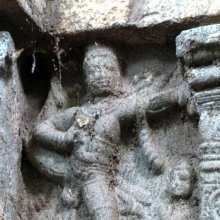Latavrishcika, Lata-vrishcika, Latāvṛścika: 3 definitions
Introduction:
Latavrishcika means something in Hinduism, Sanskrit. If you want to know the exact meaning, history, etymology or English translation of this term then check out the descriptions on this page. Add your comment or reference to a book if you want to contribute to this summary article.
The Sanskrit term Latāvṛścika can be transliterated into English as Latavrscika or Latavrishcika, using the IAST transliteration scheme (?).
Alternative spellings of this word include Latavrishchika.
Images (photo gallery)
In Hinduism
Natyashastra (theatrics and dramaturgy)
Source: Wisdom Library: Nāṭya-śāstraLatāvṛścika (लतावृश्चिक).—One of the 108 karaṇas (minor dance movement) mentioned in the Nāṭyaśāstra chapter 4. The instructions for this latāvṛścika-karaṇa is as follows, “a foot to be Añcita and turned backwards, and the left hand to be with Latā gesture its palm and fingers bent and turned upwards.”.
A karaṇa represents a minor dance movements and combines sthāna (standing position), cārī (foot and leg movement) and nṛttahasta (hands in dancing position).
Source: Shodhganga: Elements of Art and Architecture in the Trtiyakhanda of the Visnudharmottarapurana (natya)Latāvṛścika (लतावृश्चिक) refers to one of the 108 kinds of Karaṇa (“coordination of precise movements of legs and hands”), according to the Viṣṇudharmottarapurāṇa, an ancient Sanskrit text which (being encyclopedic in nature) deals with a variety of cultural topics such as arts, architecture, music, grammar and astronomy.—According to the Viṣṇudharmottarapurāṇa, karaṇas are the coordination of precise movements of legs and hands performed in a particular posture. The Nāṭyaśāstra also gives its view point in the same spirit. In the Viṣṇudharmottarapurāṇa, one hundred and eight kinds of karaṇas are accepted, e.g., Latāvṛścika.

Natyashastra (नाट्यशास्त्र, nāṭyaśāstra) refers to both the ancient Indian tradition (shastra) of performing arts, (natya—theatrics, drama, dance, music), as well as the name of a Sanskrit work dealing with these subjects. It also teaches the rules for composing Dramatic plays (nataka), construction and performance of Theater, and Poetic works (kavya).
Languages of India and abroad
Kannada-English dictionary
Source: Alar: Kannada-English corpusLatāvṛścika (ಲತಾವೃಶ್ಚಿಕ):—[noun] (dance.) one leg is tghrown back and lifted up like the tail of a scorpion and the left hand is kept is ಲತಾಕರ [latakara] (see above).
Kannada is a Dravidian language (as opposed to the Indo-European language family) mainly spoken in the southwestern region of India.
See also (Relevant definitions)
Partial matches: Vrishcika, Lata.
Query error!
Relevant text
Search found 3 books and stories containing Latavrishcika, Lata-vrishcika, Lata-vrscika, Latā-vṛścika, Latāvṛścika, Latavrscika; (plurals include: Latavrishcikas, vrishcikas, vrscikas, vṛścikas, Latāvṛścikas, Latavrscikas). You can also click to the full overview containing English textual excerpts. Below are direct links for the most relevant articles:
Gati in Theory and Practice (by Dr. Sujatha Mohan)
Gati in aerial sphere < [Chapter 3 - Application of gati in Dṛśya-kāvyas]
Elucidation of Karaṇas related to Gati < [Chapter 2 - Concept and technique of Gati]
Gati used for the delineation of Bhāva and Rasa < [Chapter 3 - Application of gati in Dṛśya-kāvyas]
Vishnudharmottara Purana (Art and Architecture) (by Bhagyashree Sarma)
2.5. Karaṇa (movements of legs and hands) < [Chapter 3 - Drama and Dance]
Natyashastra (English) (by Bharata-muni)
